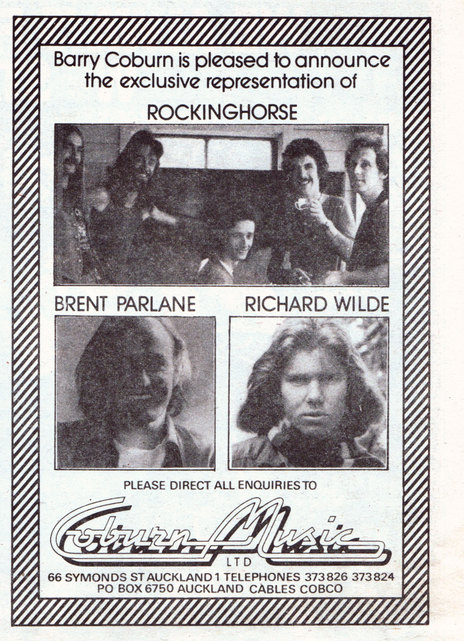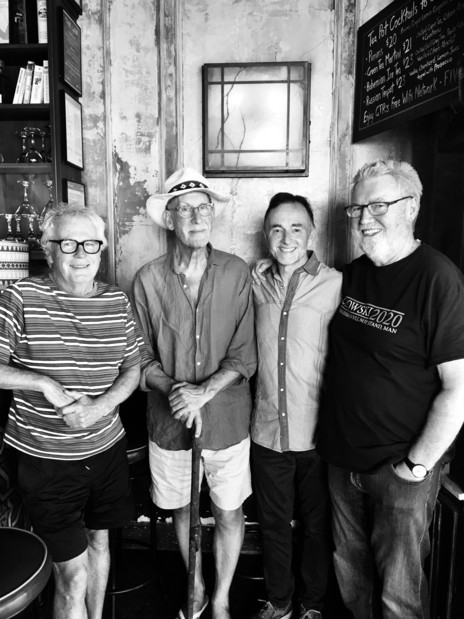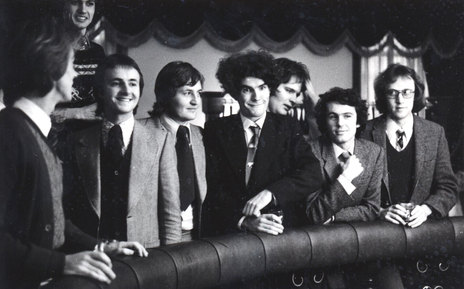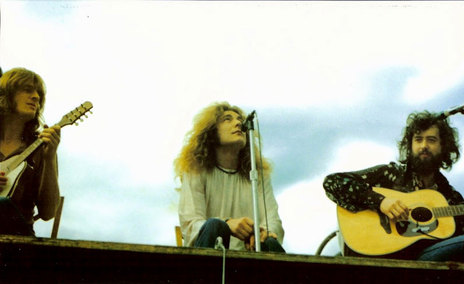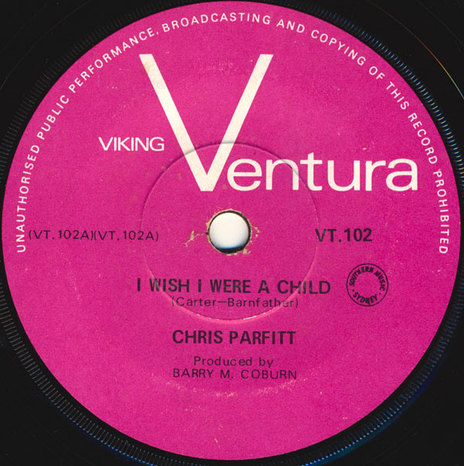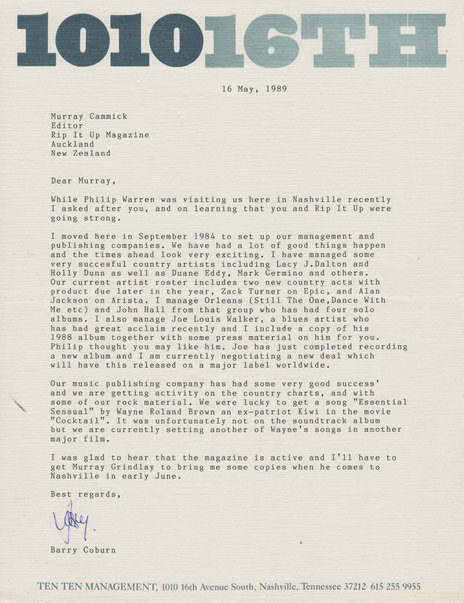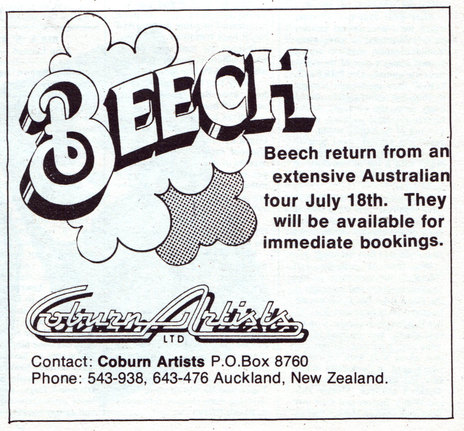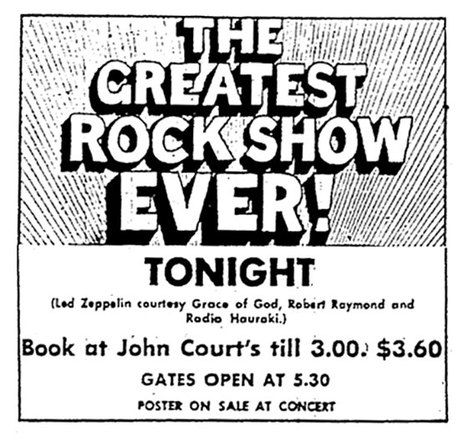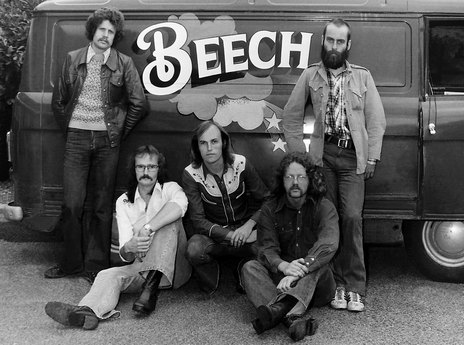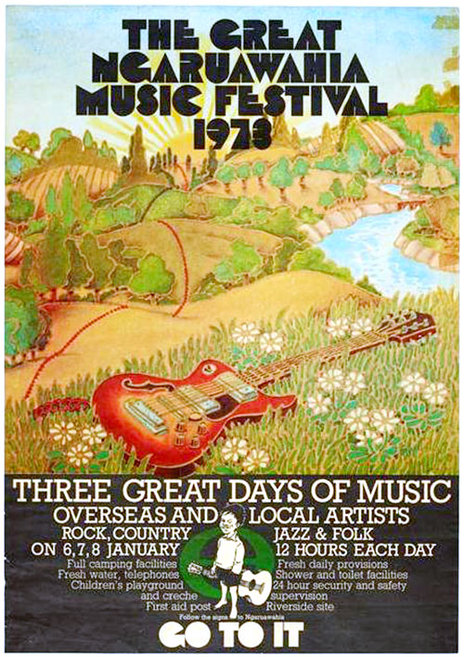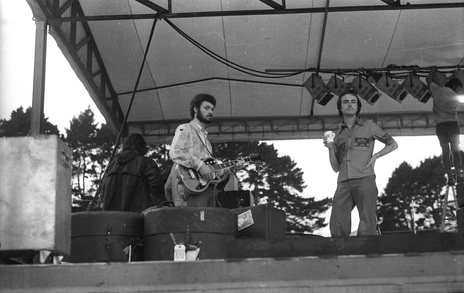In the mid-1960s, Coburn was a young teen music fan who avidly read Melody Maker music magazine and stalked the Christchurch record stores to read their Billboard and Cashbox industry magazines or sneak a peek at what the sales reps were pre-selling for release locally. Coburn briefly played keyboards in a band but soon decided he would rather get into the business side of music.
In 1967 Coburn found out that there was a warehouse job going at the Manufacturers Distribution Company (MDC) in Christchurch. The 17-year-old cut his shoulder length hair, got a suit and made an appointment to see the boss. Coburn recalled the job interview to writer Larry LeBlanc in 2011:
“ ‘Your name is Coburn. Are you related to Merv Coburn?’ I said, ‘That was my dad.’ He said ‘great’ and then he started asking me questions about music, and I answered them. Then he told me that there were two positions available. He said, ‘I’d like to consider you for the company representative position.’ I had to ask what that entailed. ‘You go out and visit all of the record stores, and you sell them records, and you call on the radio stations in towns. You will cover the whole South Island. That would be your job.’ Then he asked, ‘You do have a driver’s licence, don’t you?’ “
Coburn had only been for one driving lesson but said he nearly had his licence, so he worked in the warehouse until he could drive. Helping Coburn get the job was the fact that his father Merv had been the leader of a jazz/dance band with a weekly “Merv Coburn Orchestra” radio programme in Christchurch.
Coburn sold recordings on the Capitol, Polydor, Blue Note and Verve labels, plus local indie Viking who also represented the Roulette and Elektra labels.
Working at MDC, Coburn sold recordings on the Capitol, Polydor, Blue Note and Verve labels, plus local indie Viking who also represented the Roulette and Elektra labels. Coburn then moved to the Viking label where he did A&R and production, including successful recordings by Maria Dallas.
This writer spoke to Coburn in 2002. “When I worked for Viking Records I produced quite a bit of country stuff and a lot of that early, honky country stuff,” he recalled. “I worked out of Wellington and Auckland but I’d go to Dunedin and record people and Invercargill and Timaru.”
Viking boss Murdoch Riley saw Coburn’s potential and gave him his own label, Viking Ventura. “When Murdoch Riley let me have my own record label I was 19 and I signed a band called Salvation, out of Christchurch,” said Coburn. The group recorded their single ‘I’d Rather Be Asleep’ in Wellington with Coburn producing. His other major signing to the label was ex-Hi-Revving Tongues frontman Chris Parfitt who recorded two singles, neither of which was a sales success.
Coburn resigned from Viking in late 1970 to set up his own artist management and publishing company and he tour-managed several acts for the Australian-based promoter Harry M Miller. Tim Murdoch introduced Coburn to visiting Australian promoter Robert Raymond, who wanted to promote a Bruce Woodley (ex The Seekers) tour in New Zealand.
“I did that tour and then Robert Raymond and I decided to go into partnership together,” recalled Coburn. “We did a La De Da’s tour and I had a friend in England and we just managed to secure Elton John for Western Springs.”
Barry Coburn kept a low profile while Robert Raymond made the social pages and the news pages – being ejected from a posh restaurant for trying to dine while wearing “designer” jeans.
In the early 70s the limo driver could be the promoter himself – Phil Warren driving his own Rolls Royce for Ray Charles, or Barry Coburn trying to fathom the controls of a large American car that he borrowed from Continental Cars in Khyber Pass, Auckland. The car dealer even invested in some Coburn shows.
When I interviewed Coburn in January 2002, he recalled driving Elton John the night of his Western Springs concert, October 14, 1971:
“I went over to the White Heron Hotel to pick up Elton John in this Lincoln Continental, this huge tank, a really long one. It was left hand drive, which made me extremely nervous and it was like a ship, it floated. I pulled up at the hotel and realised I desperately needed to pee. It was starting to get dark and I couldn’t find the switch to turn on the headlamps. I parked across the street. I am pulling things and the trunk is opening, the windows are going up and down. I had this vision that this Elton John would come down the stairs and I wasn’t parked out front. I was beyond desperate to pee. I jumped out of the car and ran behind a tall tree out in front of reception and peed, trying to keep out of sight of the people in reception. I got back in the car again and with a clear mind I found the lights, pulled the car around, into the driveway and at that moment Elton and his manager John Reid came walking down the steps and we drove off to Western Springs.”
Barry Coburn was only 21 years old when he and Robert Raymond booked Led Zeppelin to play Western Springs stadium.
Barry Coburn was only 21 years old when he and Robert Raymond booked Led Zeppelin to play Western Springs stadium on Friday 25 February, 1972. UK music business contacts did not realise how young Coburn was until he arrived in London in April 1972.
The Evening Star writer Roy Colbert spent $150 on return airfares from Dunedin to Auckland to see Led Zeppelin. A long way to travel but the times were a changin’ – The Beatles or the Rolling Stones only played for 30 minutes in the 1960s but Led Zeppelin were advertised to play for three hours. The airfare was pricey compared to ticket prices, ranging from $3.10 to $4.10.
Colbert recalled the day he met Led Zeppelin in the NZ Herald (Feb 23, 2012). “I was playing cards when the promoter Barry Coburn called up and invited me to co-promoter Robert Raymond's Remuera house. I thought he was just making conversation, and I realise now they needed pot.”
Colbert got to meet the band and chat to Jimmy Page at length. Coburn asked Led Zeppelin manager Peter Grant, “Who is the best concert promoter in the world?” Grant chose Japan’s Tats Nagashima and the band’s road manager Richard Cole arranged for Coburn to learn from the master.
“So I went to Japan to go on the “Procul Harum vs Ten Years After” tour,” recalled Coburn. “We played five cities and it gave me an insight into how promoters there worked. I went on to Europe and New York. I signed Black Sabbath to do the Ngaruawahia Music Festival and 13 Australian concerts.”
Coburn and his business partner also collaborated on a record label. “Robert Raymond and I had Downunder Records for a while,” said Coburn. “We had a band called Serenity and Ticket were released on Downunder originally. We then signed Ticket directly to Atlantic through Warner Music Australia and it was the first act that had been allowed to go on Atlantic outside the USA.”
When the free music magazine Hotlicks debuted in February 1974, editor Roger Jarrett chose to do a postmortem on the important music event of 1973 – The Great Ngaruawahia Music Festival – with the story “Ngaruawahia One Year On”.
“Just after the festival, somebody said they thought it was the birth of New Zealand rock music."
– Barry Coburn
New Zealand was known to have “cultural cringe” in the 1970s – a failure to respect local music – but Hotlicks observed, “that when the New Zealand groups got behind good equipment they were as good as the overseas groups.”
Coburn agreed, “Just after the festival, somebody said they thought it was the birth of New Zealand rock music. It really just seemed it was hatching with people like BLERTA and so many groups.”
The promoters had capacity for 25,000 and the attendance was estimated to be 18,000 but the event did not cover costs. Coburn explained to Hotlicks: “Essentially the budget for the festival was $100,000. We anticipated spending $90,000 prior to the festival and we allowed $10,000 extra. Before we knew it, the thing had cost us $140,000! Robert Raymond and I were partners in the festival and we both lost a considerable amount of money.”
Following the financial failure of the Ngaruawahia Music Festival, Raymond and Coburn fell out. By 1974 Coburn envisaged the future of the music festival depending on promoters of events like the Sunbury Festival (Melbourne) getting together to book the same headliner acts for three linked January festivals – near the major cities Auckland, Melbourne and Sydney. This concept would become a reality decades later when Ken West and Vivian Lees founded the travelling Big Day Out event.
Coburn formed White Cloud Records after he split with Robert Raymond in 1973. The label released the Beech single ‘Head For Home’, Split Enz singles ‘No Bother To Me’ and ‘Maybe’, and the legendary Split Enz debut album Mental Notes.
Music reviewer J M Cummings assessed the label’s first two singles: “Beech’s ‘Ready To Run’ wins out over ‘No Bother To Me’ by Split Enz as an excellent, straight-ahead rocker at present picking up airplay. ‘No Bother To Me’ won’t be a hit but if Genesis can have a hit single then surely Split Enz can.” (Hotlicks, April 1975)
Coburn considered quitting concert promotion. “I was going to just withdraw and Robert Stigwood contacted me and asked if I would work with him to promote concert tours again and the first ones were John Mayall & the Bluesbreakers and Muddy Waters.”
Coburn only worked with Stigwood for about six months: “They promised me a whole bunch of other acts that I never got. I set up my own operation and then it was endless tours.”
Writer Dick Nicholls summed up Coburn in a Muddy Waters on-the-road story in the June, 1973 NZ edition of Rolling Stone magazine:
“I’m in the public [bar] drinking low calorie beer with Barry Coburn. He’s a diabetic and can’t take the sugar content of ordinary beer. Pop promoters are often looked on as rip-off artists by both performers and patrons, but one who definitely isn’t is the unassuming Barry Coburn. He’s been responsible for promoting some of the best concerts in New Zealand, but [there’s] one thing he doesn’t promote and that’s himself. A health food faddist passionately concerned about pollution and the French bomb tests, he’s incredibly sincere and could almost pass for a Bible-Class leader. He even disapproves of cigarette butts thrown out of car windows. Did you notice the expensive gear belonging to Split Ends who opened the John Mayall show? He’s managing them and bought them $800 worth of Fender piano! Has a local band ever had a better start? And he isn’t too worried if he’s never repaid – reckons they’ll make it and he’ll recoup it from their earnings. The way I see it, the New Zealand scene is bloody lucky to have Barry Coburn.”
Coburn also created the infamous mid-1970s buck-a-head concerts at the now demolished His Majesty’s Theatre.
Coburn saw Split Enz’s debut gig at the Wynyard Tavern in 1972. He signed the band to his management company Coburn Artists, booked their first Australian tours and in 1975 released their debut album on his independent label White Cloud Records (via Pye Records). Coburn also created the fabled mid-1970s Buck-a-Head concerts at the now demolished His Majesty’s Theatre. These shows created the performance base for the evolution of Split Ends to Split Enz and a provided a very supportive, doting Auckland audience.
“Initially the Buck-a-Head concerts were a vehicle to launch Split Enz. That’s all it was really,” Coburn told Hotlicks (May, 1976). “And we needed to expose Beech, Tolepuddle, John Hanlon … it wasn’t just a case of wanting to expose our artists because those concerts featured a lot of other artists. We produced the Buck-a-Head concerts for over a year.”
The partnership with Split Enz did not last forever. In January 1976, while Coburn was touring the Eagles in Australia, he was served with legal papers from the band.
“The papers had been created by Michael Gudinski (Mushroom Records),” said Coburn in 2002. “Split Enz wanted to part at that point and they owed me a lot of money. The claim was that they weren’t getting enough of my time, and I think they were absolutely right, but if I wasn’t doing concert tours, I couldn’t have possibly afforded to buy Mellotrons and all of the other things. The money had to come from somewhere.”
Split Enz left Coburn to join the Melbourne-based powerhouse Mushroom Records. Label owner and concert promoter Michael Gudinski soon had Split Enz living and recording in the UK.
In 2002, Coburn summed up life as a New Zealand concert promoter in the 70s – “You could make $70,000 on a tour and a month later you could lose the damn money again.”
Coburn Artists Ltd went into liquidation February 23, 1976. In Hotlicks magazine (May 1976), writer Jeremy Templer debriefed Barry Coburn on his rocky summer.
Coburn had taken on too much, having also staged nine Eagles shows in Australia plus nine Average White Band shows.
Some of the promoter’s New Zealand shows had underperformed, but not all. The Eagles sold fewer than 10,000 tickets for their Carlaw Park show, the Average White Band tour was a disaster and the costs soared on the well-attended Neil Diamond tour. In the same summer rival promoter Paul Dainty sold 30,000 tickets to the Doobie Brothers at Western Springs.
Coburn had taken on too much, having also staged nine Eagles shows in Australia plus a total of nine Average White Band shows and he needed to travel to Australia every second week.
Times were changing for the concert promoters. The new deal meant the musician was about to get the lion’s share of the door take. The two Neil Diamond shows were both very successful – 36,000 at Western Springs and 26,000 at QE2 Park in Christchurch. Coburn explained to Hotlicks, “We got a flat production fee plus a percentage of the gross – less than five percent – and our costs went up rather more than we expected.”
Listed among the assets of Coburn Artists was a debt of $13,000 owed by Split Enz. Coburn told Hotlicks, “The Split Enz thing I’m not happy about, naturally, I don’t think I got treated in a human way. They were very offhand.”
As Coburn’s “new school” company was wound up, Phil Warren’s “old school” Prestige Promotions went into voluntary liquidation. Coburn reflected, “The music business isn’t as risky as it looks. I think it looks very risky at the moment because of both Phil Warren and Barry Coburn having troubles.”
While Coburn lost money on The Eagles, Phil Warren went belly-up on five very MOR acts – Barbara Windsor in Carry On Barbara, The Black & White Minstrel Show, Patrick Cargill in Father Dear Father, Tony Christie and one-hit-wonder Daniel Boone.
Phil Warren did not like the new percentage deals of the late 1970s, forced on promoters by lawyers and accountants. “In my day I bought an act and paid the act,” he told me in 2001. “If the act bombed I lost the money, the act got their money. If the act was a riotous success I kept all the money!”
Although Barry Coburn was best known for pioneering large outdoor rock concerts his background was in New Zealand music and his management/booking company Coburn Artists worked with quite a few local artists, including Beech, John Hanlon, Brent Parlane, Rockinghorse, Tolepuddle and Richard Wilde. It was difficult for musicians to play original music on the pub circuit, so Coburn worked with the NZ Student Arts Council to create a campus circuit. Split Enz did a university tour in 1973 and returned for a February/March tour in 1974 with tickets $1.50 for students. In 1973 Coburn went to Radio Hauraki with the idea of the free Sunday summer concerts in Albert Park and when these concerts were very successful, the radio station provided free radio advertising for the “Radio Hauraki Presents” Buck-a-Head concerts at His Majesty’s Theatre.
My favourite Barry Coburn concert was the March 1975 blues show at Western Springs with a phenomenal performance by Freddie King and fine sets by Sonny Terry & Brownie McGhee, Hound Dog Taylor, Alexis Korner and Duster Bennett. “We lost quite a lot of money on that,” says Coburn. “I think I enjoyed some of it, but I just remember feeling sick. Such was life in a small market.”
In 1976 Coburn moved to Australia and found the dog-eat-dog world of concert promotion across the Tasman to be tedious. He promoted a final tour in August 1984 – Emmylou Harris and the Hot Band. Coburn and his Australian wife Jewel (a former teenage actor and country music star) headed for Nashville, USA.
Coburn struck gold signing Keith Urban, Then multi-platinum as manager for Alan Jackson.
The Coburns found the move to the US refreshing and once based in Nashville, they started a song publishing company, Ten Ten Music, and a management company, Ten Ten Management. They set about the hard work of developing the career of their new song-publishing client Keith Urban – born in Whangarei and raised in Australia.
If they struck gold signing Keith Urban, they struck multi-platinum in 1988 when Coburn signed on as manager for a new artist, Alan Jackson, and then took a risk, signing Jackson to a brand new company, Arista Nashville. “The first single went to No.46,” recalls Coburn. “Then we had 13 consecutive country number ones. Jackson exploded to be a tour headliner within a year.”
In the six years that Coburn managed Jackson, the singer sold 19 million albums. Coburn’s knowledge of touring was invaluable as he managed the Alan Jackson juggernaut: “In the last year we had five tractor trailers, three tour buses and a Lear jet and 34 people on the road plus 17 in the office. We kept all the merchandise rights and we were selling half a tractor-trailer load some nights, of T-shirts, posters, photos, key rings.”
In 1999, Ahmet Ertegun flew Coburn to New York and talked him into accepting a large corporate salary to be President and CEO of Atlantic Records Nashville. But in 2001 after the AOL Time Warner merger, Coburn and all but one of his staff were made redundant when all the conglomerate’s Nashville labels were merged into one business. Coburn returned to publishing, still on full pay from Atlantic for the duration of his contract.
Ten Ten Music continues to have success in both the country and rock genres. Tim Finn is one of the writers published by the company. Barry Coburn has served on the Board of Directors of USA performing rights organisation ASCAP since 2007 and is also a member of the Board of Directors of the National Music Publishers Association.
